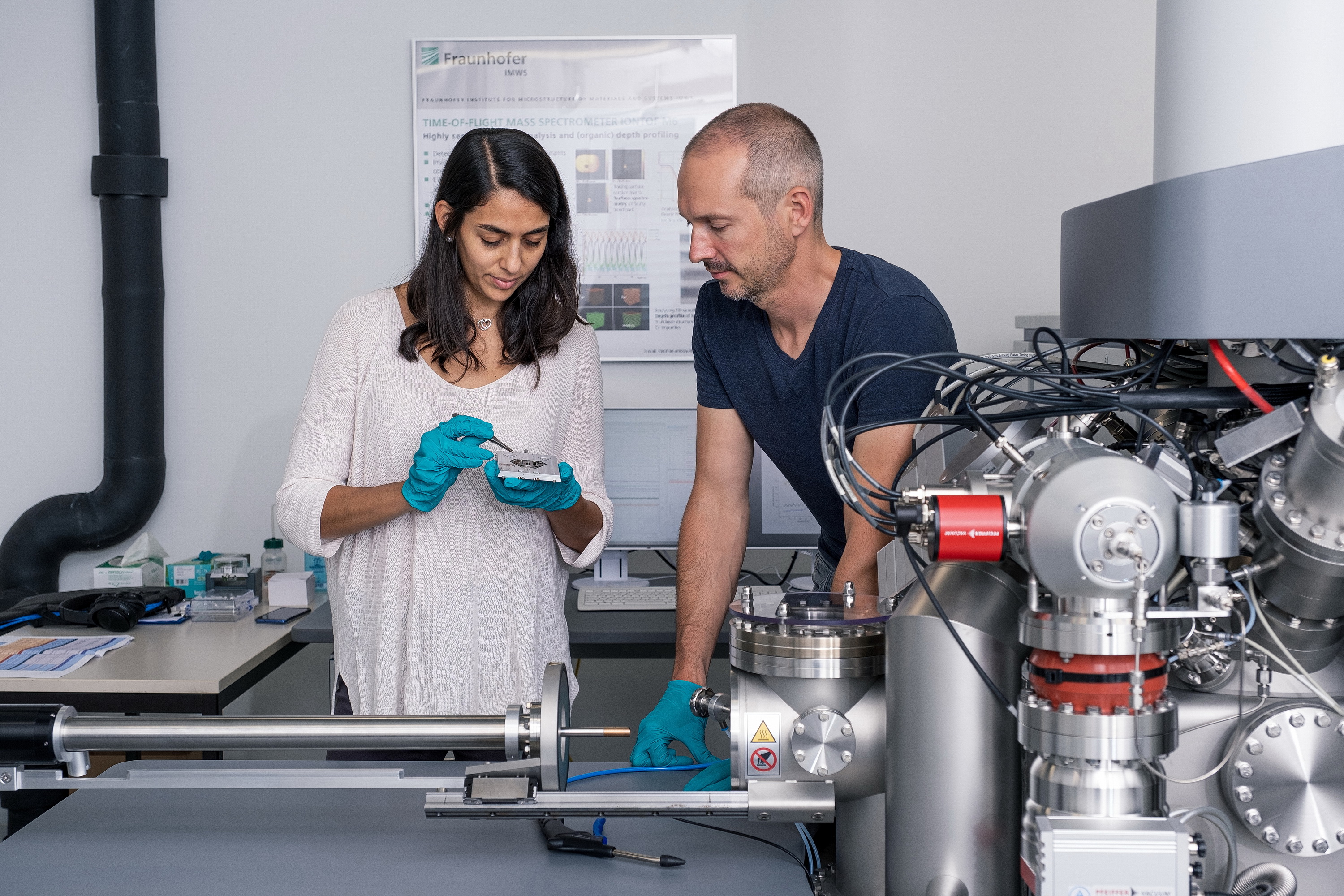ToF-SIMS stands for Time-of-Flight Secondary Ion Mass Spectrometry. It is a method for analyzing material surfaces and structures.
Frequently asked questions about ToF-SIMS
What is ToF-SIMS?
How does ToF-SIMS work?
The measuring principle is based on exposing the surface of a sample to be examined to pulsed bombardment with primary ions. When these primary ions hit the sample, secondary ions are knocked out of the sample. These secondary ions are charged positively or negatively and can therefore be steered in a specific direction within a negatively or positively polarized field. In ToF-SIMS devices, they are guided into a time-of-flight analyzer where they are separated according to their masses. This is possible because ions with different masses move at different speeds in the electrostatic field: Light ions fly through the field faster and reach the detector sooner, while heavy ions are slower and arrive at the detector later. The mass can therefore be determined from the flight time and the element can then be deduced from this.
Which elements and compounds can be detected with ToF-SIMS?
In principle, almost all elements and compounds can be separated and detected with high sensitivity according to their different masses. There are limitations in the analysis of hydrogen, nitrogen and noble gases. By using a special ion source, the ToF-SIMS device used at the Fraunhofer IMWS offers the possibility of carrying out depth profiling even in organic sample setups. A cooling function means that volatile materials can also be analyzed with ToF-SIMS.
What is ToF-SIMS used for?
ToF-SIMS offers a wide range of possibilities for material diagnostics, especially for surface analysis. For example, The method is used for characterization during development, the analysis of surfaces and interfaces, material diagnostics, quality control, defect diagnostics and the investigation of coatings and layer systems. At the Fraunhofer IMWS, the method is primarily used for application-oriented questions in the fields of microelectronics and optical materials, for example for the investigation of bond contacts in electronic components, high-tech laser mirrors or innovative protective coatings. There are two basic analysis options (measurement modes):
- Surface analysis: For quasi-non-destructive trace analysis of elements and identification of (complex) organic and inorganic compounds on surfaces (2-5 monolayer detection depth). A BiMn emitter is used here as the primary ion source.
- Depth profile analysis: For depth-resolved trace analysis of elements in solid volumes and for the characterization of thin film systems (depth resolution in the sub-nm range). Cs+ or O2+ ion sources are used to successively ablate the surface during depth profiling of inorganic material systems. Furthermore, the use of a special GCIB (Glass Cluster Ion Beam) ion source available at the Fraunhofer IMWS enables the depth-resolved analysis of complex organic and inorganic molecules without destroying the long-chain fragments.
What can ToF-SIMS do that other analytical methods cannot?
Methods such as SEM, TEM, AFM, FTIR or Raman spectroscopy offer a wide range of possibilities, but are limited in terms of detection sensitivity, surface sensitivity or the ability to detect not only individual elements but also compounds, particularly in surface analysis. ToF-SIMS often proves to be a suitable method of choice, as it provides detailed elemental and molecular information about the surface of the sample. The method offers a very high surface sensitivity (information depth < 1 nm), a very high detection sensitivity for almost all elements (even very light elements such as hydrogen, lithium and boron) and is virtually non-destructive because the very low primary ion currents generally only ablate the top 1-2 atomic layers of the sample. However, information about deeper sample areas can also be generated easily and with high sensitivity by ablative (non-destructive) ion bombardment. Lateral resolutions in the < 100 nm range and depth resolutions even in the sub-nm range are possible, which means that a three-dimensional representation of the element and compound distribution in the analyzed sample volume can also be produced.
What options are available at the Fraunhofer IMWS?
At the Fraunhofer IMWS, ToF-SIMS measurements are carried out on the TOF-SIMS5-100 (masses greater than 9000 u, spatial resolution < 150 nm in Imaging, < 300 nm in UMR and ~ 7 µm in HMR) and TOF-SIMS M6 (masses greater than 12,000 u, spatial resolution < 50 nm in Ultimate Imaging Mode and < 90 nm in Fast Imaging Mode) devices from iontof company. The latter also offers the possibility of carrying out the described depth profiling in organic sample setups by using a special ion source. The maximum dimensions of a sample are 70 mm x 50 mm x 19 mm. By using a cooling function, volatile (or non-vacuum-compatible) samples can also be cooled down to -180 °C (using liquid nitrogen) and thus detected. For example, ethanol or water can also be detected in an ultra-high vacuum. The measuring range is typically in the range of 10x10 µm² to 500x500 µm². Samples can be turned, rotated and tilted in the device.
The scientists at the institute have excellent knowledge of this method, which has been used at the Fraunhofer IMWS since 2007, as well as a wide range of options for efficient sample preparation. In addition, a wide range of other methods for nanoanalysis and characterization of surfaces and sample volumes are available.
